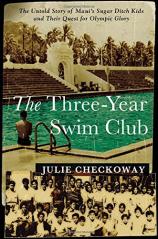The Three-Year Swim Club: The Untold Story of Maui's Sugar Ditch Kids and Their Quest for Olympic Glory
Review
The Three-Year Swim Club: The Untold Story of Maui's Sugar Ditch Kids and Their Quest for Olympic Glory
Destiny is a curious thing. Sometimes it’s planted in a child’s heart, where it’s then pursued and captured single-mindedly. In others’ lives, it remains elusive, uncertain and unknown until a series of events finally reveals it.
Imagine that you’re living in 1930s Maui. Life is beautiful. You’re enjoying all that the Hawaiian islands have to offer: delightful scenery, ocean breezes, tasty food. If you’re a haole (of non-Hawaiian ancestry, or white), you’re living the sweet life there. You may even own a sugarcane plantation.
Now imagine that you’re one of the multitudes of laborers in the sugarcane fields. You may be Japanese-American, Filipino or Chinese, and every day you take your machete into the fields and chop. The workday is backbreaking and exhausting. All the workers live in tiny attached houses in the camp, alongside the cane fields. And every family knows what’s happening with every other family, whether it’s no food at the end of the month, arguing spouses, or some other trouble. Poverty is everywhere, and the sweet life is nonexistent.
Camp children, though, are plentiful. And like all children, they’re vastly creative. Without much in the way of toys, they make up games from sticks, seed pods and gravel. But their best-loved game is a forbidden --- and terribly dangerous --- one.
"This story of one (at first) seemingly unremarkable man and his effect on camp children and the world of swimming is both inconceivable and dazzling. You won’t want to miss it."
Sugarcane fields require vast quantities of water to grow even a single pound of sugar. To provide more water for the drier valleys of Maui, plantation owners built ditches to bring water from the wetter mountain regions of the island down to the fields. Then they used more ditches to carry both water and waste from the fields down to gated reservoirs. Some ditches had muddy bottoms, while others were paved with concrete. But when the sluices were opened up at the fields, the water and cane refuse hurtled down the ditches at a treacherous speed. Both animals and some children were caught in the current and met their own deaths. Still, neither that possibility nor the severe punishment from plantation officials kept the children out of the water. It was absolutely irresistible to them.
Soichi Sakamoto was a second-generation Japanese-American living in Hawaii. And he just didn’t fit into his parents’ plans for a responsible Nisei son. As a child and a young man, he was both impetuous and rebellious. In desperation, his folks sent him to the Territorial Normal School, which they hoped would make of Soichi a teacher. Although he never really took to the school, he did indeed become a teacher, at the camp Pu’unene elementary school. Then his wheels began to turn. Soichi found and married, after a very brief courtship, a woman of Hawaiian ancestry named Mary. He was absolutely certain that she was his other half, who would enable him to find his destiny. He began to throw himself into extracurricular activities, becoming the Scoutmaster for the camp scouts troop and founding a children’s basketball team (though he’d never played himself) and a track team.
The day that decided the destiny of both Soichi and the camp children was the day he emerged from the elementary school and encountered over a hundred wet, naked and delighted boys and girls pouring out of the ditch. After their exciting water ride, they were pursued by a furious official on horseback, whose heart was set on punishment. Certainly these children knew better! However, every one of them managed to escape him. Soichi, who knew the utter lack of joy and positive activity in their lives, made an offer. Although he had no idea how to swim, he volunteered to supervise the children as they played in the ditch, when it was pooled rather than rushing. As he stood and “babysat” them, ideas began to churn in his head. As author Julie Checkoway says, “Soichi Sakamoto had no good reason to do it, no right to, no knowledge of how to, but he called out to the children, nonetheless, ‘How ‘bout I teach you something about swimming, eh?’”
This simple question, and the resulting creation of the Three-Year Swim Club, is the turning point in both Soichi’s and the children’s lives. Early on, his goal for them was Olympic glory. He asked them to commit to three years of serious practice. And, astonishingly, he became the coach who turned these poverty-stricken youngsters, whose future hopes were previously just a job in the cane fields, into record-breaking champions. Along the way, they experienced heroes and villains, peace and war, heartbreak and victory.
This story of one (at first) seemingly unremarkable man and his effect on camp children and the world of swimming is both inconceivable and dazzling. You won’t want to miss it.
Reviewed by Melanie Reynolds on October 29, 2015
The Three-Year Swim Club: The Untold Story of Maui's Sugar Ditch Kids and Their Quest for Olympic Glory
- Publication Date: October 27, 2015
- Genres: History, Nonfiction, Sports
- Hardcover: 432 pages
- Publisher: Grand Central Publishing
- ISBN-10: 1455523445
- ISBN-13: 9781455523443





